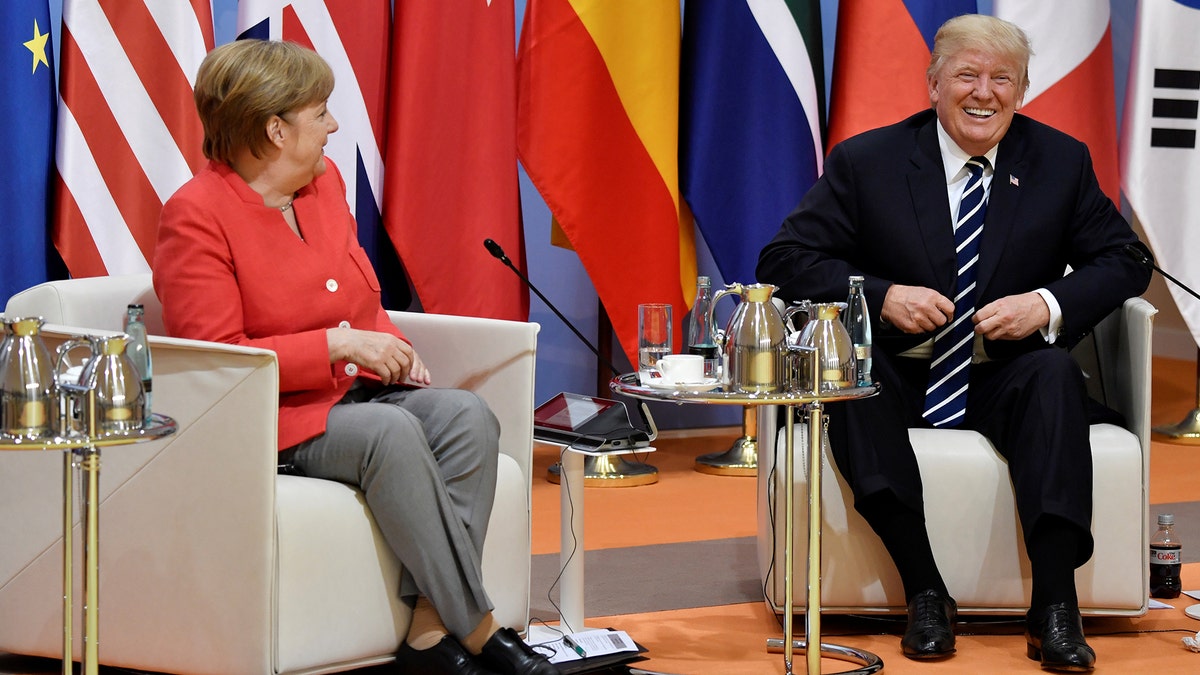
German Chancellor Angela Merkel and US President Donald Trump share a laugh at the start of the "retreat meeting" on the first day of the G20 summit in Hamburg, Germany, July 7, 2017. REUTERS/John MACDOUGALL,POOL - RTX3AG9G (REUTERS/John MacDougall-Pool)
While there are plenty of critics of President Trump’s approach and style, many of his foreign policy decisions have been strong and decisive and stand in stark contrast to those of the Obama administration.
The Trump White House relishes American exceptionalism and enjoys promoting Western values. It clearly understands that there is no such thing as leading from behind when it comes to tackling the most pressing international security issues.
One clear difference can be seen with how the two administrations have gone after ISIS. After withdrawing all U.S. troops from Iraq and naively referring to the terror group as a “JV team,” President Obama found himself scrambling for a new strategy and was forced to send thousands of American soldiers back to the war-torn nation.
When President Trump became commander in chief, he decided to take a new approach and unleashed the generals to crush the enemy. From dropping the largest non-nuclear bomb in our arsenal to hit ISIS tunnels in Afghanistan to the American-backed liberation of Mosul in Iraq, President Trump is making good on his word to go on offense in the war on terror and destroy ISIS.
An “America First” foreign policy should not be confused or conflated with promotion of an isolationist view. Instead, it is a way to unite our allies to pursue common goals that are American priorities.
Another contrast has come from how each president has handled Syria. President Obama chose to draw an imaginary red line as a “stern warning” to stop Syrian President Bashar al-Assad from using chemical weapons. Ignoring this warning, the Assad regime used chemical weapons in August of 2013, killing an estimated 1,400 people, many of them children. Team Obama then walked away from its red line and left Assad unpunished. Sadly, chemical attacks continued.
Testing a new White House, Assad used chemical weapons again in April and President Trump responded by hitting a Syrian airfield used in the attack with 59 Tomahawk cruise missiles. A new standard was set; tyrannical dictators cannot use weapons of mass destruction without serious repercussions.
In President Obama’s first year in office he canceled a missile defense shield that was set to be stationed in Poland and the Czech Republic. This was part of his failed “reset” policy to warm relations with Russia and the beginning of his outreach to Iran. Ironically, by the end of his second term, President Obama was sanctioning Russia for invading Ukraine and meddling with our presidential election. And President Obama was defending a disastrous nuclear deal with Tehran.
Conversely, President Trump has tightened sanctions on Iran and deployed the Terminal High Altitude Area Defense (THAAD) missile defense system in South Korea to protect that nation, Japan and others in the region from North Korea’s growing missile and nuclear program.
The regime in North Korea is racing to develop intercontinental ballistic missiles that can deliver a nuclear weapon to our homeland. The deployment of THAAD is one of several decisions to demonstrate that the era of “strategic patience” is over.
The Trump administration has also taken other actions to bolster the defense of our allies around the world.
A newly signed $110 billion arms sale to Saudi Arabia will help an important regional partner upgrade its military, act as a check on Iran and defeat Islamist extremism while creating American jobs. More recently, the Trump administration announced a $1.3 billion arms deal with Taiwan, an island democracy and ally under constant threat from China.
None of these developments was welcomed by Russia, North Korea, China or Iran. However, it was very important to send a new signal to the rest of the world: America will no longer sacrifice the security of our allies to placate the wishes of our adversaries.
The Trump administration’s notable actions have not simply been relegated to deals or deployments. It has also requested a $54 billion increase in military spending, conducted aggressive counterterrorism operations, and routinely called for each NATO member countries to spend 2 percent of its GDP on national defense.
All this is important, because unmatched military power is not just a necessary asset to winning wars – it is a key to preventing wars.
In May I led a congressional delegation and met with security officials in France, Poland, Estonia, and Ukraine. The topics of our meetings included counterterrorism, cybersecurity, missile defense and NATO, and varied with each stop. There was a consistent theme throughout: American leadership and strong allies are needed to defeat our most serious threats.
Under President Obama, many allies did not trust us, and enemies did not fear us. President Trump has clearly reversed that course.
President Trump repaired strained relations with Israel, our great friend that was embarrassed by the Obama administration at the U.N. Security Council in December. Our new president called for the United States to stand with the Cuban people and not the oppressive Castro regime. And President Trump’s impressive national security team is not only embracing, but strengthening our leadership role on the international stage.
An “America First” foreign policy should not be confused or conflated with promotion of an isolationist view. Instead, it is a way to unite our allies to pursue common goals that are American priorities.
I may not agree with President Trump on each and every issue, but his administration has clearly demonstrated that the world can be a much more peaceful and prosperous place when America leads from the front.




















